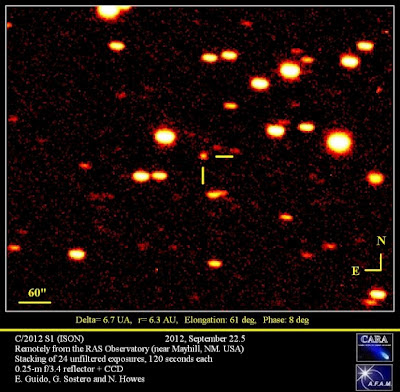Bright New Comet on the Way
There’s another comet on the way. And this might be a great one. Called Comet C/2012 S1 (ISON), this comet is about as far away as Jupiter, but it’s expected to buzz the Sun late next year and, if it stays intact, may become as bright as the full Moon.
The comet was discovered by a Russian team of astronomers at the International Scientific Optical Network (ISON). At magnitude +18, the comet is currently beyond the reach of amateur telescopes. But the orbital elements have been calculated, and they show the comet will come amazingly close to the Sun– just 2 million km— on November 28, 2013. In mid-November through December 2013 and into January 2014, the comet may reach negative magnitudes, possible as bright as -11 to -16, which means it will be visible during the day!
Because their composition is not exactly known, each comet is unpredictable. So no one can knows for sure how bright this comet will become, or if it will survive its close encounter with the Sun. Still, this is promising news. And this comet, unlike many recent bright comets, will be visible at mid-northern latitudes.
Southern stargazers will get their own bright comet next year. Comet Pan-STARRS is expected to become visible without optical aid next March, and come within 45 million km of the Sun on March 9, 2013.
So get your binoculars, telescopes, and cameras ready. Next year should be a good one for bright comets, perhaps the best year since 1996 when Comets Hyakutake and Hale-Bopp graced our skies…
- Source: One Minute Astronomer
- More... Space.com










